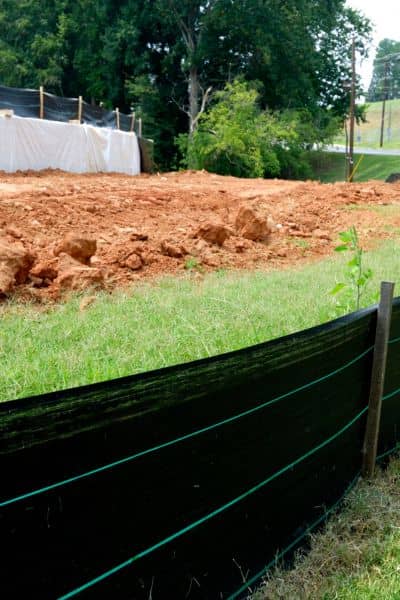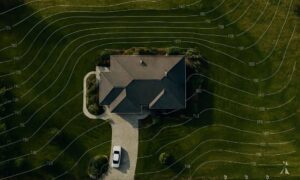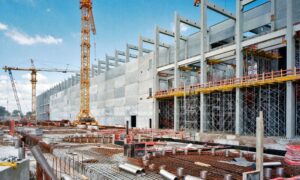
When Goldman Sachs released images of its new Dallas campus this week, most headlines focused on jobs, office culture, and architecture. But for civil engineers, the real story is different. An 800,000-square-foot campus in the middle of Victory Park highlights a challenge every Dallas developer faces: stormwater design.
Stormwater design is not flashy, yet it is critical. It decides how water flows through a site, where it collects, and how it leaves without damaging streets, utilities, or property. In a dense urban area like Victory Park, stormwater planning becomes even more urgent. The Goldman Sachs project is big enough to spark new conversations, but the lessons apply to every project, from subdivisions to office parks.
Why Stormwater Matters in Victory Park
Victory Park is one of Dallas’ busiest neighborhoods. Packed with high-rises, restaurants, and event spaces, it already deals with traffic and heat. Add another massive development and you add more rooftops, more pavement, and more cars. That means less ground for rain to soak into and more pressure on drainage systems.
In storms, water that can’t soak in must be managed. Without proper stormwater design, runoff builds up, floods streets, and damages property. Poor planning also strains the city’s existing infrastructure. For a site the size of the Goldman Sachs campus, the volume of water could be huge. Multiply that by frequent Texas storms, and the risk of flooding grows.
The question is not whether Dallas needs better stormwater solutions—it’s how quickly new projects adopt them.
Dallas’ Rulebook for Stormwater
Dallas has clear rules for stormwater. The city relies on two main standards: the Drainage Design Manual (DDM, 2019) and the Integrated Stormwater Management (iSWM) criteria developed by the North Central Texas Council of Governments.
Here’s what those standards mean for a project like Goldman Sachs’ campus—and for any other site in the city:
- Detention requirements: Stormwater can’t just be pushed downstream. Engineers must design detention ponds, vaults, or underground systems to store water and release it slowly.
- Water quality volume (WQv): The first flush of runoff, often filled with oil, trash, and chemicals, must be treated or filtered. Bioswales, sand filters, and green roofs are some options.
- Overland relief: Dallas requires proof that if pipes or ponds reach capacity, water can still exit the site safely without flooding neighbors.
- Operations and maintenance plans: The city doesn’t just want construction drawings. It also wants long-term maintenance strategies so systems keep working after the ribbon-cutting.
These rules apply across the board. Whether you’re building a downtown tower or a suburban shopping center, the reviewers at City Hall expect the same level of detail.
Heat, Mobility, and Stormwater Work Together

While stormwater is the focus, it never stands alone. The new campus shows how stormwater connects with two other major issues: urban heat and mobility.
Heat and Hard Surfaces
Victory Park already struggles with heat. Concrete and asphalt trap warmth and push local temperatures up. Stormwater systems can help offset that. Green infrastructure—like rain gardens, shaded detention basins, and reflective pavements—can lower heat while managing water. Designing for runoff and designing for cooler streets can go hand in hand.
Mobility and Construction Staging
Getting thousands of employees in and out of Victory Park will test Dallas traffic. But construction itself also creates mobility problems. Trucks, staging areas, and road closures all interact with stormwater systems. If erosion control measures fail, runoff can spill into streets, clog drains, and worsen traffic. Careful staging and strong erosion control plans keep both water and traffic flowing smoothly.
When engineers think about water, heat, and mobility as one system, they create resilient sites that serve communities instead of stressing them.
Lessons for Developers and Owners
It’s easy to assume that a global company like Goldman Sachs has unlimited resources. Yet the city will hold it to the same standards it uses for smaller projects. That means the lessons apply whether you are building a single subdivision or a large office park.
Lesson 1: Detention is non-negotiable. Every site must account for storage. If you don’t have room for a pond, you need creative alternatives like vaults, underground tanks, or shared regional detention.
Lesson 2: Plan for water quality at the start. Developers often focus on drainage rates but forget filtration. Adding bioswales or vault filters late in the process can be costly. Build them early.
Lesson 3: Show overflow routes. City reviewers want clear hydrology models. They expect to see where water will flow if the system is overloaded. That means detailed maps, not vague notes.
Lesson 4: Tie stormwater to long-term operations. A system without maintenance is a future failure. O&M plans, inspection schedules, and clear responsibilities protect both owners and cities.
What Prospective Clients Need to Know
For many property owners and project managers, stormwater feels like an afterthought. The focus often goes to architecture, marketing, or financing. But in Dallas, stormwater is a gatekeeper. Without approved designs, permits stall. Without maintenance plans, certificates of occupancy don’t come through.
Ignoring stormwater can add months of delays and thousands of dollars in redesigns. Worse, it can create long-term liabilities if systems fail during storms.
Prospective clients should see stormwater not as a technical detail but as a business decision. A well-planned stormwater system keeps projects moving, protects investments, and avoids expensive surprises.
A Simple Scorecard for Any Project
If you’re preparing a project, ask yourself these five questions:
- Do I know my detention requirements?
- Has water quality treatment been integrated early in the design?
- Are overflow routes mapped and approved?
- Does my erosion control plan match the construction schedule?
- Is there a maintenance strategy with clear responsibilities?
If you answered “no” to any of these, stormwater design may slow your project later. Addressing it early ensures smoother reviews and better outcomes.
Closing Thoughts
The Goldman Sachs campus is the latest high-profile project in Dallas, but it’s also a case study. Behind the renderings and press releases lies a reminder: every project must respect water. Stormwater design is not optional. It’s a core part of land development that connects to heat, mobility, and long-term city growth.
Civil engineers see stormwater as both a challenge and an opportunity. Developers should too. By planning early, following manuals, and linking design to real-world performance, projects can move forward without costly setbacks.
For prospective clients, the takeaway is clear. Whether you’re developing a corporate campus, a retail center, or a residential subdivision, stormwater design shapes your success. Do it well, and you protect your investment. Do it poorly, and you risk delays, fines, and future failures.
Goldman Sachs’ Dallas campus may have the spotlight, but the same rules apply to every project in the city. No matter where you build, stormwater isn’t just about engineering—it’s about creating safe, smart, and lasting development.





